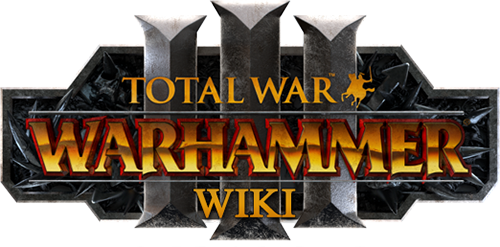 |
Outdated
This page is in need of being brought up to date. Please help Total War: WARHAMMER Wiki by fixing inaccurate or outdated information. |
Siege battles are fought over fortified cities. To gain control of the city, the attacking armies must breach the defences and either capture the victory point or rout the defending armies.
In campaign, siege battles happen when an army sieges a settlement.
The attacker may use siege weapons, artillery, or monsters to attack the fortifications.
The defender may station units on the walls to defend them, and may direct the fire of wall towers against the enemy. Selected Infantry can be instructed to scale the fortifications using ladders by right-clicking.
Siege battle attackers may take capture points to gain control of gates, towers and other tactical features.
Total War: Warhammer III changes[ | ]
| Please help improve this article or section by expanding it. Further information might be found on the article's talk page. |
In Total War: Warhammer III, siege battles were reworked to become similar to survival battles. City maps are larger, having platforms for the defender to fire from above or around corridors.
Instead of a single victory point, the defender must control several capture points in addition to the victory point to gain supplies, which can be spent on barricades and towers to stop the attacker. If a capture point is taken by the attacker, any defences built by the defender will be destroyed.
Capture Points[ | ]
Towers, gates and other fortified features may be captured by an attacker during a siege battle if they take control of the nearby capture point.
The attacker may begin the capturing process by clearing the defenders out of a capture point and positioning a unit within it. The capture process takes a short time. A capture point is taken once the defender’s flag is run down the central flagpole and the attacker’s flag is run up.
The capture process may be interrupted by the defender counter-attacking. The defender may also retake a capture point. Victory points behave like capture points but determine control of the entire settlement.
Victory Points[ | ]
An attacker may capture the victory point in a siege battle to win the battle and take control of the settlement. Victory points behave much like capture points, and are attacked and defended in the same manner. Once a victory point is taken the attacker does not immediately win. Instead, a timer begins to count down. Once this timer reaches zero, the attacker wins. The defender may interrupt the countdown by retaking the victory point.
The victory point icon can be viewed at all times on the battle interface during a siege battle.
Strategies[ | ]
Attacking[ | ]
- The biggest damage dealer in a siege is not enemy infantry, but enemy towers. They have a reach well into the deployment zone on most maps and plenty of coverage. Make it a priority to either evade their fire (by getting close to the walls with units), protect your units (actual shields or cheaper infantry as meat shields), or destroy them using artillery.
- Siege towers preserve the infantry on approach, but are notoriously fragile and frequently get destroyed while halfway in. The infantry inside suffers 50% casualties, so it might be more advantageous to have regular infantry, especially faster units, set up ladders. Of course, ladders only permit one unit per ladder, leading to issues with penetrating enemy resistance. Ladders also cause severe Fatigue to the unit, and should be used sparingly lest your army becomes Exhausted.
- The same doesn't go for rams. They are durable, but slow, and once they get to the gates, it's going down. Have at least one to gain access for cavalry inside the city.
- At any rate, the priority is to neutralize the towers, then get into the city. Marshal forces and attack the victory point for a quick victory. Easier said than done, though, as the defenders are very resilient. Taking out the gates allows cavalry to move in, which can greatly turn the odds in your favor.
- Fighting the defenders on the battlements is optional, but will ensure no counterattacks in the back. Occupying them with some infantry is generally a good idea and once inside the city, you can rout them with ease.
- However, getting ranged units onto the battlements is a very good idea. Any defenders get pelted with arrows and projectiles, stripping their leadership faster than you could hope for.
Defending[ | ]
- Defending is a little more complex, especially with a small force. There are two goals:
- Prevent the enemy from taking gates, to hamstring their cavalry and force them onto the battlements.
- Destroy the enemy piecemeal.
- As expected, ranged units shine in this situation. Focus fire on the most dangerous infantry formations first, to force them to rout and flee or soften them up before they get on ladders. Your shooters have the advantage on the parapets.
- The exception are enemy siege engines. If there are towers or rams, focus fire to destroy them first.
|
